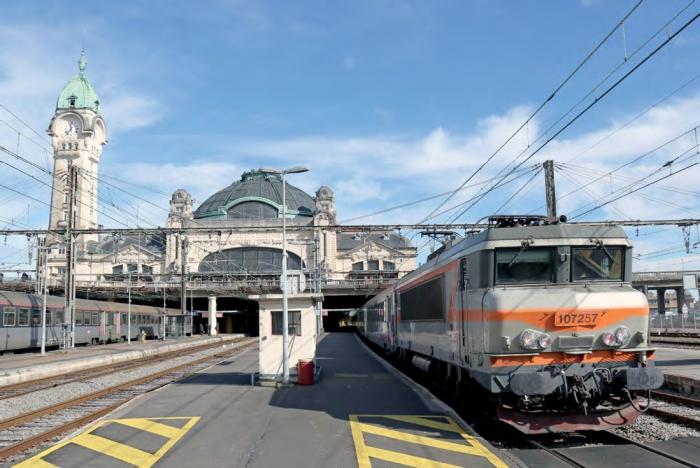EUROPE

GREEN SPEED – EUROSTAR AND THALYS TO MERGE
In late September the owners of international high-speed operators Eurostar and Thalys announced plans to merge the two companies.
As both are majority owned by French Railways (SNCF), the drive for the merger has clearly been led from Paris. The plan is supported by Belgian Railways (SNCB), a 5% shareholder in Eurostar and minority shareholder in the two Thalys operating and commercial companies, plus Patina Rail LLP (a consortium of Canadian bank Caisse de depôt et placement du Québec and funds managed or advised by Hermes GPE LLP (‘Hermes Infrastructure’)), which now owns the former British Government 40% stake in Eurostar.
The merger will create a €1.7 billion revenue company to be branded ‘Green Speed’. It brings together Eurostar, which had revenues of £1.029 billion from 11 million passengers in 2018 (resulting in an operating profit of £96.6 million), and Thalys, whose profits are not separately published, with 2018 revenues of €527 million from 7.5 million passengers. The new company’s shareholders say the aim of the merger is to increase annual passenger numbers to 30 million in the decade to 2030. The combined operator will serve five countries – France, the UK, Belgium, the Netherlands and Germany – around 245 million people. Simpler through ticketing, improved loyalty schemes and an eco-friendly approach through use of renewable energy and ‘sustainable purchasing’ are amongst the benefits touted for the merged entity.
TWO INTO ONE
Eurostar, which celebrates 25 years of operation between London, Paris and Brussels this year, has a fleet of 17 892-seat Class 374 Siemens Velaro e320 trains and retains 10 of the original 794-seat Class 373 trains, all of which are due to be refurbished. Eurostar has 1,650 employees and operates 47 trains a day covering 7.9 million train kilometres annually. Thalys began operating services between Paris and Brussels with services also serving Cologne and Amsterdam in 1996. Over half its passengers are carried on the Paris to Brussels route alone.
Originally part-owned by the national operators in France (SNCF, 62%), Belgium (SNCB, 28%) and Germany (DB, 10%) and set up as a co-operation arrangement, Thalys became a legal entity in March 2015, at which point DB ceased to be an owner. The new Thalys is structured as a company called THI Factory, which is owned 60% by SNCF and 40% by SNCB, with its own safety case certification and a commercial and sales organisation called Thalys International (owned 70% by SNCF and 30% by SNCB). Thalys trains use traincrew from the national rail operators in France, Belgium and the Netherlands. In Germany SNCF subsidiary SNCF Voyages Deutschland provides drivers.
Thalys has a fleet of 27 TGV trains dating from 1994-98 (17 quadri-voltage for service into Germany and 10 tri-voltage TGV Réseau derived trains for use between Paris and Amsterdam), which were shared among the state railways that first established the operation (NS has two TGV sets, DB no longer has its two). These are maintained at depots in Paris and Brussels with servicing activities in Amsterdam, Cologne and Dortmund. Thalys has 641 employees and operates 66 trains a day covering 9.4 million train kilometres annually.
Like Eurostar, Thalys has grown its network in a limited way since commencing operations, with services extended from Cologne to Dortmund in Germany in 2015. It also offers seasonal services to the same destinations as Eurostar, connecting Brussels with French ski resort Bourg St Maurice in winter and Marseille in summer as well as serving Marne-la-Vallée and Paris Charles de Gaulle airport twice daily. Since June Thalys has operated summer weekend services from Brussels to Bordeaux. Thalys previously offered services from Brussels to Geneva but withdrew these.
In 2016 Thalys launched a low-cost Paris to Brussels pseudo high-speed service branded ‘Izy’, which uses the lower-cost classic route between Paris and Arras before using the high-speed line to Brussels. Izy services initially used a specially branded TGV Réseau set, often supplemented by one in Thalys colours, but since this year has used a dedicated former Eurostar Class 373 set.
NEW SERVICES?
The proposed merger, which is subject to EU merger control competition clearances, would bring together the commercial operations of both operators and longer term may enable expansion of the network and services offered.
One example could be through services from London to German cities, although currently the Eurostar Class 374 trains, whilst designed for potential use in Germany, are not equipped with German safety systems or approved for use there.
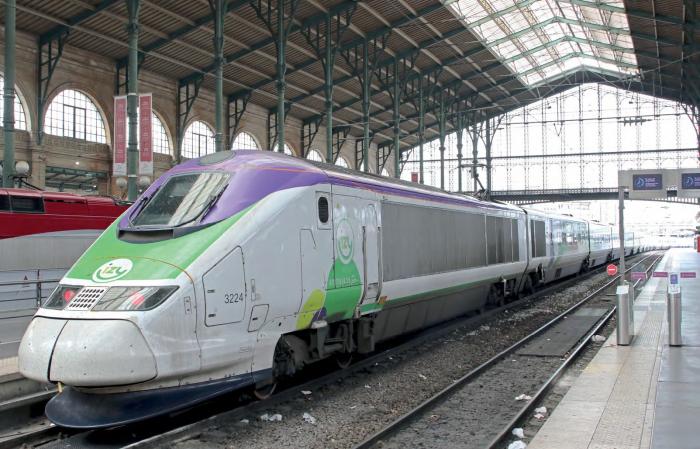

In the short to medium term simpler through ticketing to German destinations served by connecting Thalys services in Brussels from the UK and vice versa is likely. Whether this will kill off plans by German national operator DB and Eurostar to reinstate through tickets from London to almost all German stations (as opposed to the seven currently served by Thalys) is unclear, although DB is now selling through journeys via its online channels, albeit with the need to select the Eurostar connection (and price) desired.
The new combined company could offer major synergies, especially for new train procurement; the remaining Eurostar Class 373 sets dating from 1992-93 will need replacement within a decade, as will the entire Thalys fleet. The merger will give ‘Green Speed’ the option to buy a new fleet of trains able to operate in all five countries served, plus the Channel Tunnel. If operation of 200-metre trains in multiple in the Channel Tunnel was permitted (as planned by DB in 2010 when ICE services to London were proposed) then portion working with trains coupling and uncoupling in Brussels could for example allow through services from London and Paris to serve both Amsterdam and Dortmund (or elsewhere in Germany) without adding expensive high-speed line train paths in France and the UK.
TRAINS REPLACE PLANES
Dutch airline KLM has announced it will replace one of its five daily flights between Brussels and Amsterdam Schiphol with reserved seat capacity on Thalys high-speed trains from 29 March 2020. KLM intends to remove further flights by instead using Thalys services over the coming years, with the aircraft take-off and landing slots saved at Schiphol airport enabling it to expand inter-continental services.
There are many other instances of high-speed services directly serving hub airports being used by airlines to replace short-haul flights; Thalys already operates from Brussels to Paris Charles de Gaulle airport, with Air France selling some of the seats. In Germany Lufthansa code shares multiple ICE services operated by DB and consequently has removed many domestic connecting flights, for example between Düsseldorf, Cologne, Stuttgart and the country’s main hub airport at Frankfurt, which has a purpose-built high-speed rail hub station.
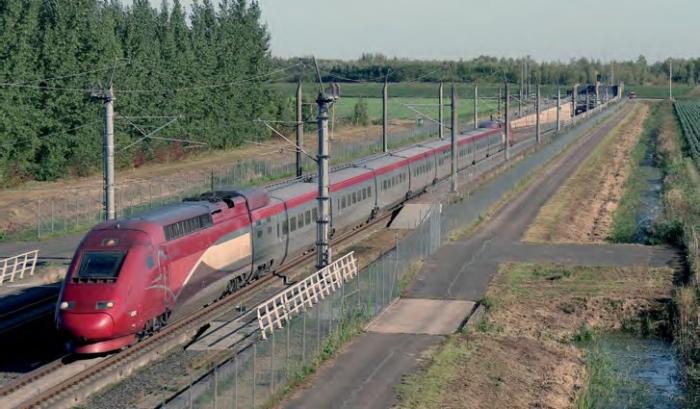
CZECH REPUBLIC
TRAXX 3 FOR REGIOJET EXPANSION
Open access operator Regiojet has ordered 15 new electric locomotives from Bombardier.
The new locos are the first of Bombardier’s Traxx 3 multi-system design to be ordered for passenger use and will be equipped for operation from 1.5kV/3kV DC and 15kV/25kV AC, enabling their use in the Czech Republic and all neighbouring countries.
Regiojet has announced it will standardise its loco fleet on the Bombardier Traxx design based on the experience gained with the four Traxx 2 MS Class 386.2 locos that it has in service; four more are on order and options for up to 20 more exist, in addition to the order for the new Traxx 3 locos. Once the Traxx fleet has been expanded Regiojet intends to cease use of Vectron MS locos hired from European Locomotive Leasing; currently the operator has six in use.
Regiojet also has a small fleet of Skoda-built Class 162 3kV DC-only locos dating from the early 1990s, which are restricted to the Prague – Ostrava – Košice route. Much of Regiojet’s planned expansion is international and requires multi-system locos. In mid-2019 Regiojet raised CZK921 million (€36 million) to finance fleet expansion from selling five-year bonds to institutional investors, and as well as new locomotives the company plans to buy over 100 secondhand coaches to expand its fleet. In July it announced it had bought 18 couchette cars from DB in Germany to expand its existing overnight service between Prague and Košice/Humenne in eastern Slovakia. This train now loads to 18 coaches and routinely carries around 1,000 passengers!
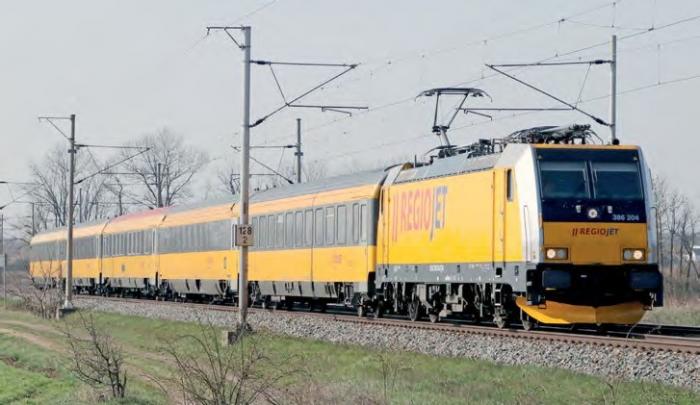
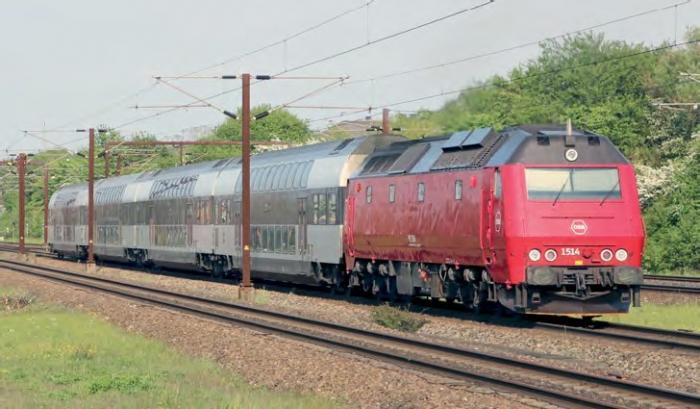
DENMARK
DIESEL LOCOS TO BE PHASED OUT FROM 2022
Despite recent investment in emissions reduction equipment for national operator DSB’s fleet of Class ME Co-Co diesel locos (built between 1981 and 1985 by Henschel) and full overhauls of around one-third of the remaining 32 locos, DSB has decided to cease further overhauls and withdraw the entire fleet by December 2021, replacing it with the 26 new Siemens Vectron electric locos which are due for delivery from 2020 onwards. DSB will also withdraw the five Class EA electric locos that remain in Denmark when the Vectron fleet is in service. Once the ME diesels are withdrawn only a small number of diesel locos used for freight and infrastructure trains will remain in use in Denmark; almost all transit and longer-distance freight is already hauled by electric locos. Many regional lines and DSB itself use large numbers of DMUs.
The Vectron fleet will be used with the existing fleet of 113 Bombardier-built double deck coaches operating services between Copenhagen and Næstved, Odense and Kolding. DSB is reported to be tendering for 56 new coaches to be operated by Vectron locos between Copenhagen and Hamburg, replacing the current DSB IC3 DMUs used (entirely under the wires from December when these services are permanently diverted from the Rødby to Puttgarden train ferry).
FRANCE
CAF WINS FRENCH INTERCITÉS TRAIN ORDER
French national long-distance operator SNCF Mobilités announced in mid-September that it had selected CAF to build 28 new 200km/h 10-car articulated EMUs for loco-hauled Intercités services on the routes from Paris to Clermont Ferrand and Toulouse (via Limoges) from 2023. SNCF Mobilités had undertaken the tender on behalf of the French Government, on whose behalf it operates the government supported trains d’équilibre du territoire (TET) ‘Intercités’ branded services. The contract includes options for up to 75 more trains, 15 of which have been assigned to potential use on the Marseille – Toulouse – Bordeaux route.
The first firm order is worth €700 million. CAF will assemble the trains at its French factory in de Bagnères-de-Bigorre, which it acquired from CFD (Compagnie de Chemins de Fer Départementaux) in 2008, and at its Beasain factory in Spain. CAF has announced plans to add 250 employees at the French site to produce the order.
SNCF Mobilités has the current five-year contract to operate the non-high-speed long-distance TET network (branded as Intercités) until the end of 2020, but the French Government is committed to tendering parts of the network, providing rolling stock from the new TET fleets it has funded in recent years (all of which is currently used and maintained by SNCF). The Government plans to tender the rather sparse Nantes – Bordeaux and Nantes – Lyon services first, with the aim of awarding a contract from 2022 onwards. The other TET routes that have not been transferred to the regions will follow.
Separately, following a debate in which banning domestic flights was mooted (but not supported), the French Government has announced plans to impose additional ‘eco taxes’ on air travel, with the resulting €180 million revenue earmarked for investment in the rail network.
FLIXTRAIN BIDS FOR PATHS IN FRANCE
Open access operator Flix Mobility, based in Germany but backed by international financial investors, has applied for train paths to operate in France from early 2021. The company has applied for paths on four main routes as follows:
Paris Nord – St Quentin – Brussels (five train pairs daily);
Paris Austerlitz – Poiters – Bordeaux (two train pairs daily);
Paris Austerlitz – Limoges – Toulouse (two train pairs daily);
Paris Bercy – Lyon (five train pairs daily).
An overnight train service between Paris Bercy and Nice is also planned and it is reported FlixTrain hopes to obtain French Government support for this service.
The new services will compete with French national operator SNCF’s high-speed and conventional services as well as Thalys services between Paris and Brussels. The FlixTrain model as successfully developed in Germany is to offer alternative services between key cities which are not necessarily as fast as those of other operators.
FlixTrain has demonstrated in Germany that passengers will willingly trade speed and a modern train for a cheaper journey in an older carriage (most of the coaches in use with FlixTrain in Germany date from the 1970s/1980s or earlier). As Flix already operates FlixBus services on all the routes it is planning from Paris it will have a ready-made customer base for its new services and already has the necessary online booking and information systems to rival SNCF’s oui.sncf app and website.
Exactly how the services will be operated is not currently clear, although as in Germany operation will be sub-contracted to non Flix Mobility operators. Obtaining rolling stock approved for use in France may be challenging as SNCF has not sold any of its extensive Corail fleet for reuse in Europe and in recent years has not resold its withdrawn rolling stock at all, preferring to scrap it. The service level planned by FlixTrain will require several rakes of stock. Locomotives could be obtained from leasing company Akiem (part-owned by SNCF), which has 30 Class BB36000 200km/h locos (built from 1996 to 2001 by Alstom). Whilst other leasing companies have Bombardier Traxx locos equipped for use in France, these currently have limited approval for passenger use in the country (with a maximum speed of 140km/h in force).
FlixTrain’s preferred loco type in Germany – the multi-system Siemens Vectron – is not yet approved for use in France despite the introduction of simplified cross-border approvals within the EU and is unlikely to be approved there before 2024.
FlixTrain has also announced plans in recent weeks to expand its existing network in Germany from December and to enter the Swedish market in mid-2020, serving the country’s two main routes from Stockholm to Gothenburg and Malmö (both of which already have open access competitors in addition to national operator SJ).
IRELAND
NTA TO REVIEW RAIL TO NAVAN IN 2020
The National Transport Authority (NTA) will specifically consider the reopening of the M3 Parkway to Navan railway as a part of the 2020 statutory review of the current strategy for the Greater Dublin Area 2016 to 2035 in the context of the Irish Government’s Climate Action Plan.
The line between Clonsila (on the Dublin – Sligo line) and M3 Parkway was reopened on 3 September 2010. The proposed extension to Navan consists of 34km of railway on the route of the former Dublin and Meath Railway line, which closed to passengers in 1947 and completely in the 1960s. Stations are proposed for Dunshaughlin, Kilmessan and Navan town centre, with a further station on the northern edge of Navan. As recently as December 2018 the Government had reminded Parliament that when the strategy was published in 2016 demand was ‘insufficient to justify the development of a high-capacity rail link at the current time’, with a bus link proposed instead. A second route to Navan exists from Drogheda (on the Dublin – Belfast line), still used by freight. Tim Casterton
IÉ DIESEL FLEET DEVELOPMENTS
With the cancellation of plans for multi-engine rebuilding, as we have reported previously, Iarnród Éireann (IÉ) has completed repairs and overhaul of accident damaged loco No 225, although No 230 from the ‘Enterprise’ cross-border fleet remains in store following an engine fire and is unlikely to be returned to service in the foreseeable future unless it is used as a testbed for a new type of diesel engine.
On 5 October 2019 201 Class loco No 232 operated a special charter train in multiple with 071 Class locomotive No 078; this was the first time this had happened in service. Whilst the IÉ 201 Class locos were built by General Motors in 1994 and fitted with standard EMD multiple working equipment (as were the earlier 071 Class locos), use of it had not been permitted. A senior IÉ traction engineer with a ‘can do’ attitude personally oversaw this first ever operation of the two classes working in multiple. Tim Casterton
NETHERLANDS
HOOK OF HOLLAND LINE FINALLY REOPENS
The Schiedam Rotterdam West to Hook of Holland line reopened as part of the Rotterdam (RET) metro system on 30 September, connected to it via a new viaduct built at Schiedam west of the city centre, although the short section to Hoek van Holland Strand will not open until 2022 following local planning disputes.
The heavy rail line was closed for rebuilding to metro standards on 31 March 2017 and was originally due to have reopened by the end of 2017, although commissioning delays (especially for signalling) prevented this, with the first test runs taking place over 12 months before the line actually reopened to passengers.
The new light rail services are operated using the HSG3 series three-car EMUs bought by RET in 2015-16 from Bombardier specifically for the network extension to Hook of Holland.
The branch line from Schiedam, west of Rotterdam, to Hook opened in 1891 and was electrified at 1,500V DC in 1935. Boat trains to and from Hook formerly served a wide range of international destinations, connecting with ferries from East Coast ports in the UK, latterly from Harwich. The last international service from Hoek ended in 1993 to Warsaw via Berlin, although NS continued to run direct Hoek van Holland to Amsterdam boat trains operated using EMUs until 2006. Our thanks to reader John Morris for some of this information.
SPAIN
ALSTOM WINS BARCELONA METRO CONTRACT
Alstom will supply Barcelona metro operator Transports Metropolitans de Barcelona (TMB) with 42x5-car ‘Metropolis’ EMUs. The contract is worth around €260 million, with delivery due by the end of 2021. Twenty-four of the trains will be for TMB’s Line 1, which is built to 1,672mm gauge, whilst the other 18 are for use on Line 3, which is standard gauge. The trains, which will be built in Barcelona, will replace older trains dating from the 1980s.
